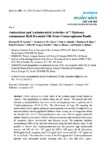Use este identificador para citar ou linkar para este item:
http://www.alice.cnptia.embrapa.br/alice/handle/doc/965349Registro completo de metadados
| Campo DC | Valor | Idioma |
|---|---|---|
| dc.contributor.author | AZEVEDO, M. M. B. | pt_BR |
| dc.contributor.author | CHAVES, F. C. M. | pt_BR |
| dc.contributor.author | ALMEIDA, C. A. | pt_BR |
| dc.contributor.author | BIZZO, H. R. | pt_BR |
| dc.contributor.author | DUARTE, R. S. | pt_BR |
| dc.contributor.author | CAMPOS-TAKAKI, G. M. | pt_BR |
| dc.contributor.author | ALVIANO, C. S. | pt_BR |
| dc.contributor.author | ALVIANO, D. S. | pt_BR |
| dc.date.accessioned | 2013-09-02T11:11:11Z | pt_BR |
| dc.date.available | 2013-09-02T11:11:11Z | pt_BR |
| dc.date.created | 2013-09-02 | pt_BR |
| dc.date.issued | 2013 | pt_BR |
| dc.identifier.citation | Molecules, v. 18, n. 1, p. 1128-1137, Jan. 2013. | pt_BR |
| dc.identifier.uri | http://www.alice.cnptia.embrapa.br/alice/handle/doc/965349 | pt_BR |
| dc.description | Croton cajucara is a shrub native to the Amazon region locally known as ?sacaca?. Two morphotypes are known: white and red ?sacaca?. The essential oils (EO) obtained by hydrodistillation from leaves of the red morphotype were, in general, rich in 7-hydroxycalamenene (28.4%?37.5%). The effectiveness of these EO regarding the antimicrobial activity against pathogenic microorganisms was initially investigated by the drop test method, showing significant inhibition zones. Among the microorganisms tested, the essential oils rich in 7-hydroxycalamenene were more effective against methicillin resistant Staphylococcus aureus (MRSA), Enterococcus faecalis, Mycobacterium tuberculosis, M. smegmatis, Mucor circinelloides and Rhizopus oryzae. The minimum inhibitory concentrations (MIC) of the oils were determined using the broth dilution assay. It was possible to observe that 7-hydroxycalamenene-rich oils presented high antimicrobial activity, with MIC of 4.76 × 10−3 μg/mL for MRSA, 4.88 μg/mL for M. tuberculosis, 39.06 μg/mL for M. smegmatis, and 0.152 μg/mL for R. oryzae and 3.63 × 10−8 μg/mL for M. circinelloides. The antioxidant activity of this EO suggests that 7-hydroxycalamenene provides more antioxidant activity according with EC50 less than 63.59 μg/mL. Considering the bioactive potential of EOs and 7-hydroxycalamenene could be of great interest for development of antimicrobials for therapeutic use in treatment of bacterial and fungal infections in humans and/or veterinary practice. | pt_BR |
| dc.language.iso | eng | eng |
| dc.rights | openAccess | eng |
| dc.subject | Óleos essenciais | pt_BR |
| dc.subject | Atividade antimicrobiana | pt_BR |
| dc.subject | Atividade antioxidante | pt_BR |
| dc.title | Antioxidant and antimicrobial activities of 7-hydroxycalamenene-rich essential oils from Croton cajucara Benth. | pt_BR |
| dc.type | Artigo de periódico | pt_BR |
| dc.date.updated | 2016-02-22T11:11:11Z | pt_BR |
| dc.subject.nalthesaurus | Croton cajucara | pt_BR |
| riaa.ainfo.id | 965349 | pt_BR |
| riaa.ainfo.lastupdate | 2016-02-22 | pt_BR |
| dc.identifier.doi | 10.3390/molecules18011128 | pt_BR |
| dc.contributor.institution | MARIANA M. B. AZEVEDO, UFRJ; FRANCISCO CELIO MAIA CHAVES, CPAA; CATIA A. ALMEIDA, UFRJ; HUMBERTO RIBEIRO BIZZO, CTAA; RAFAEL S. DUARTE, UFRJ; GALBA M. CAMPOS-TAKAKI, UFPE; CELUTA S. ALVIANO, UFRJ; DANIELA S. ALVIANO, UFRJ. | pt_BR |
| Aparece nas coleções: | Artigo em periódico indexado (CTAA)  | |
Arquivos associados a este item:
| Arquivo | Descrição | Tamanho | Formato | |
|---|---|---|---|---|
| 2013060.pdf | 192,77 kB | Adobe PDF |  Visualizar/Abrir |









